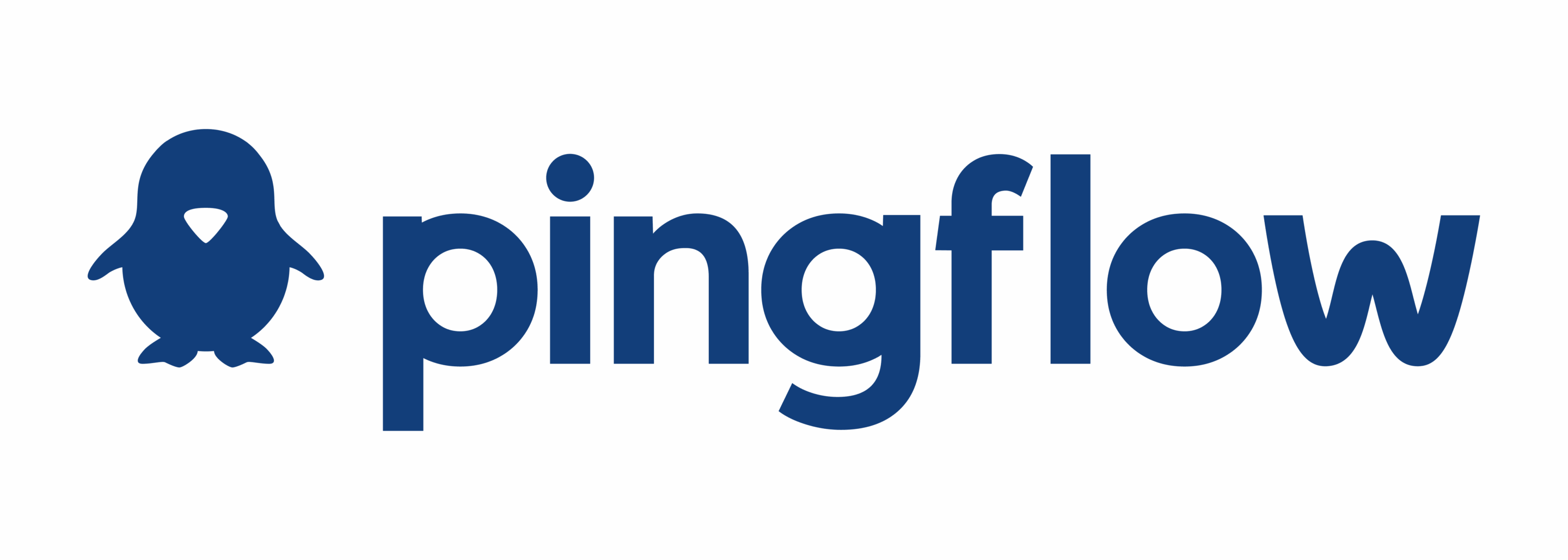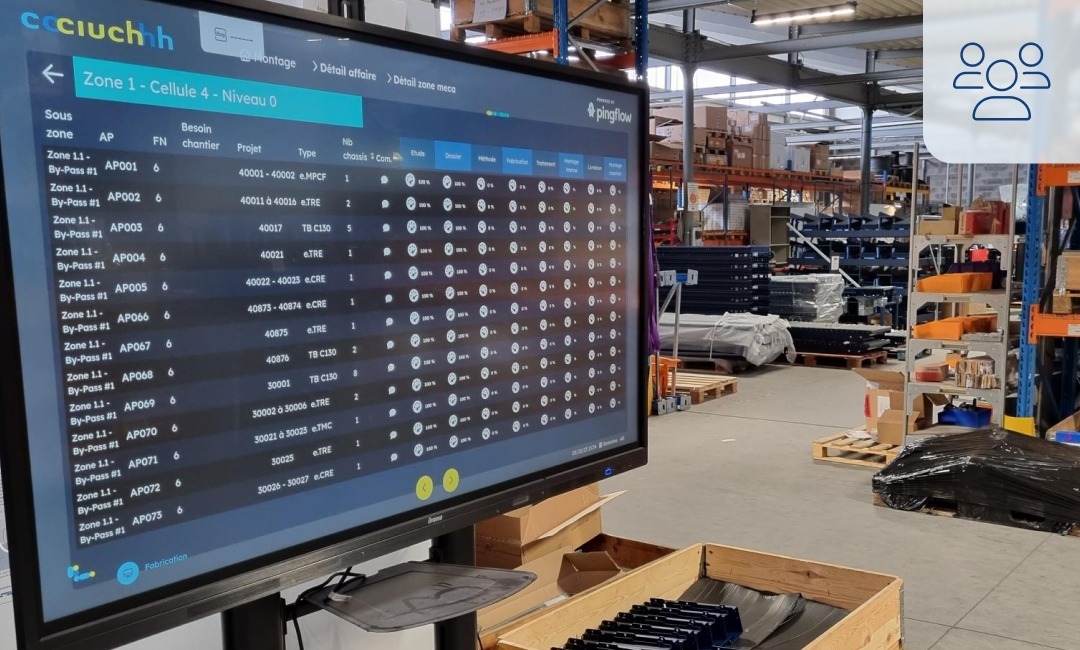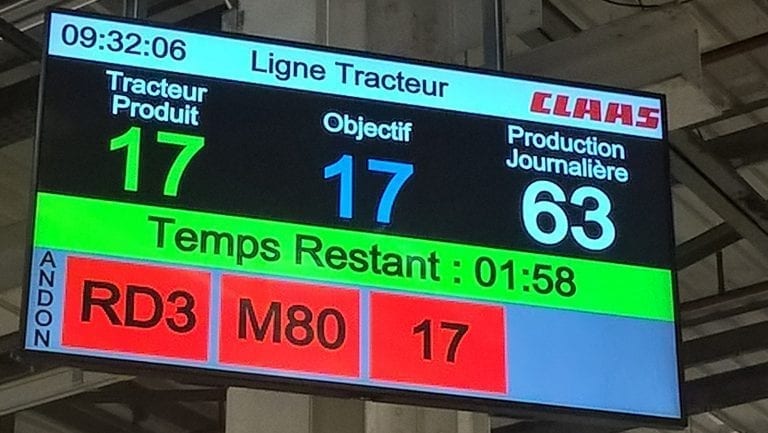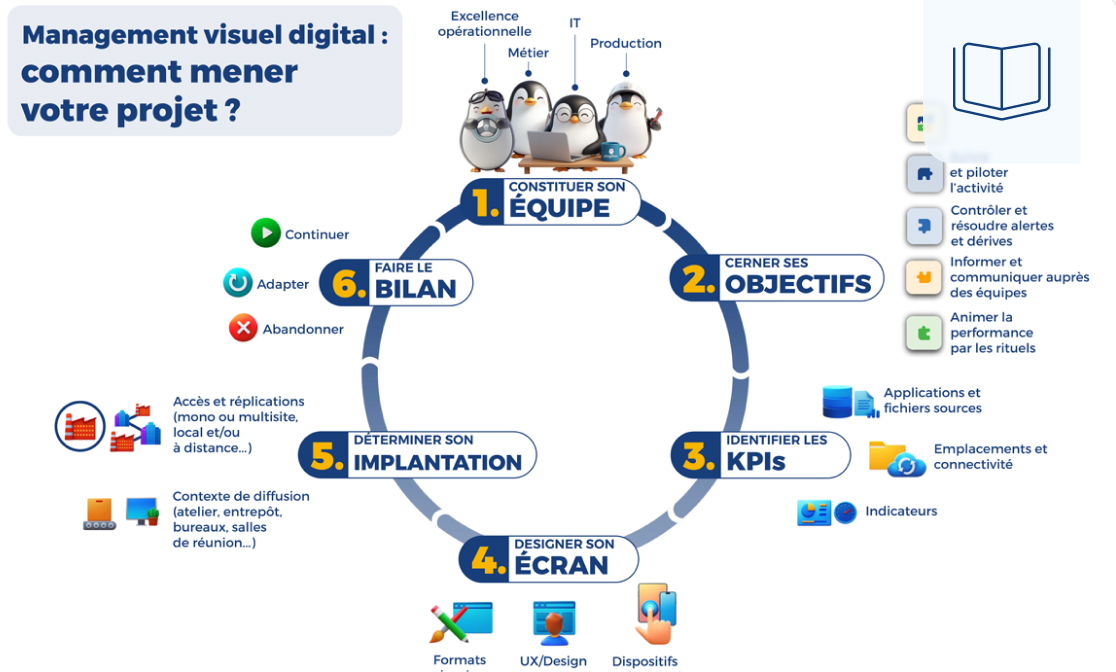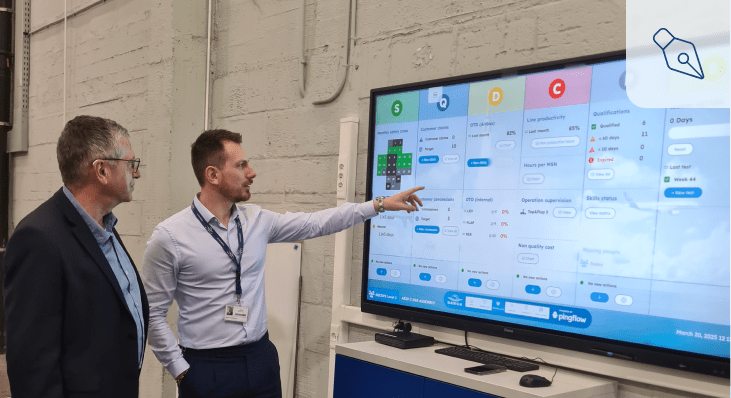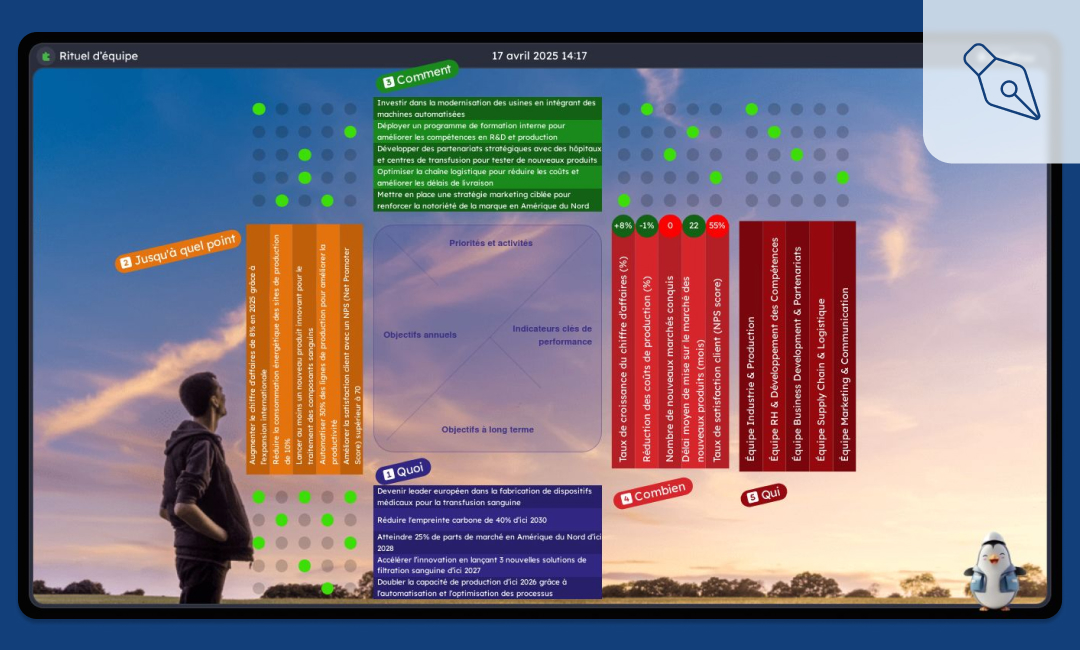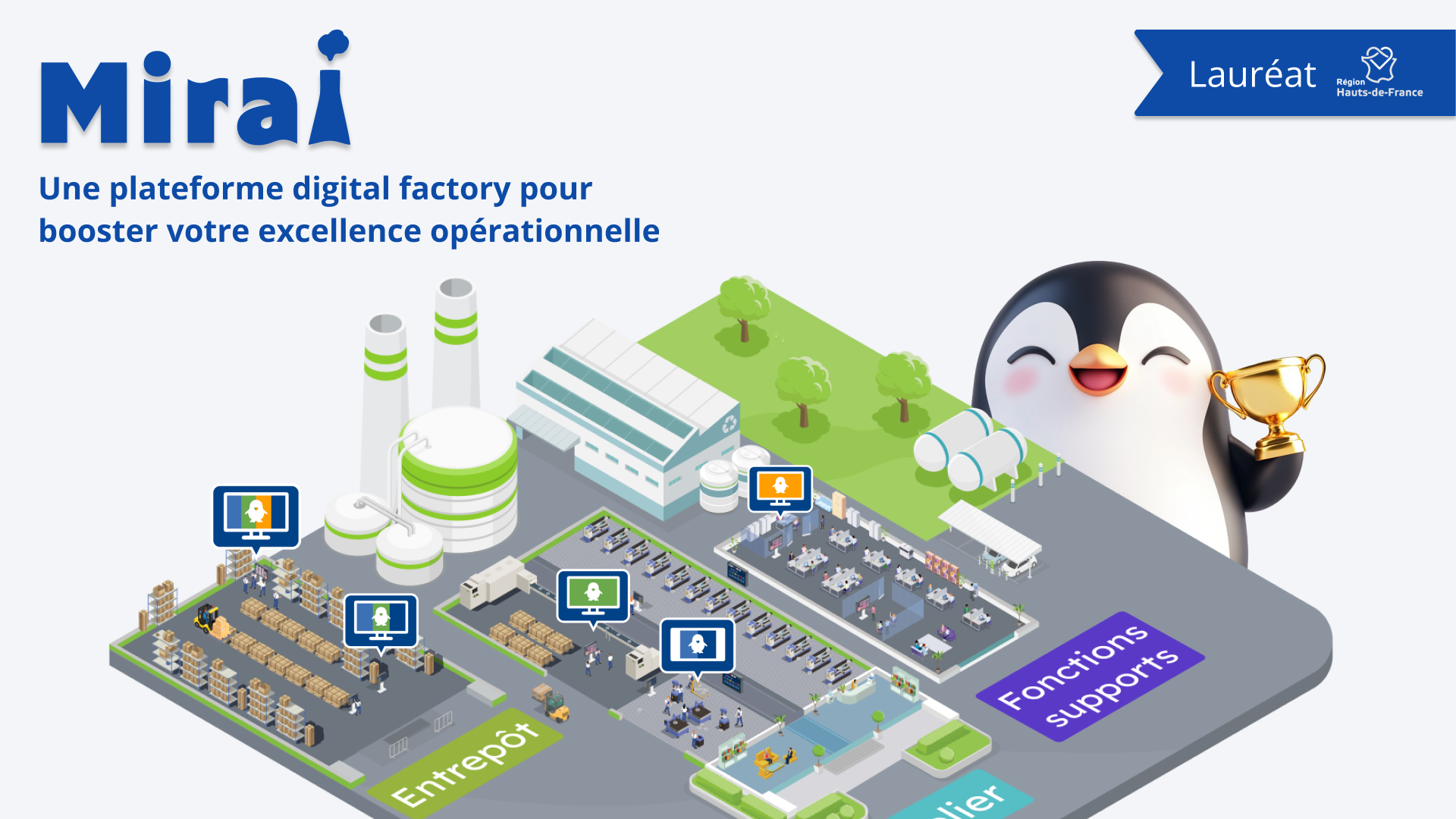How Ciuch digitalizes (and optimizes) its production monitoring
Founded in Tourcoing in 1966, the Ciuch group (around 160 employees) is a leader in the field of intralogistics solutions. It designs and manufactures complete logistics systems that can be configured (almost) as easily as Lego: custom-made conveyors (10 km produced per year!), controlled by the Ciuch WCS (Warehouse Control System) software.
Its clients? Major players, retail startups, 3PLs (service providers that manage the entire supply chain for their customers), and other logistics integrators. These are all players for whom logistics has become a key issue and who rely on Ciuch’s turnkey solutions to ensure perfectly optimized warehouse flows.
Driven by this context and the e-commerce boom, Ciuch experienced explosive growth: doubling between 2016 and 2021. This impressive performance, but also required industrialization and the development of production methods, notes Bruno Galiot, the industrial director who joined the company in mid-2021. “We managed production with a little Excel, a lot of email exchanges, and even more memory!”
The challenge? Structure the business, optimize industrial processes, and restore visibility to all stakeholders in the production chain.
The observation: “weekly” production management, neither in real time nor visible to the teams
Coming from the machine tool industry, working for major clients in the automotive and aeronautics sectors, Bruno Galiot quickly set out to introduce management based on indicators and production monitoring into his organization. The goal? Simple: « that what we designed in the design offices be manufactured on time. » Here’s how they went about it.
A first step: modeling the flows
Well-oiled physical flows…
The first step to digitizing production monitoring? Examine and model the organization to gain a clear view of flows. At Ciuch, creating a logistics system involves several steps:
- The design office, which designs the system and places the order internally.
- The actual manufacturing of the various system components.
- Surface treatment (painting, zinc plating, etc.) is subcontracted externally before being returned to Ciuch.
- Mechanical assembly, and, in parallel, the wiring workshop for the electrical component.
- Shipment in a single batch to the customer’s final site for installation and commissioning (always handled by Ciuch).
…but information flows to be optimized…
Visualizing the “path” of a customer order’s elements through the various workshops is essential, but it’s not enough. You also need to model:
- What information is needed: progress status of a part, completion or non-completion of a step, etc.
- Who provides this information: the plant manager, the workshop manager, the operator, etc.
At Ciuch, monitoring was mainly done through Excel files (one per workshop), which worked satisfactorily… as long as we stayed within the scope of each workshop. Because these monitoring files did not communicate with each other, and therefore remained primarily the tool of each workshop manager. Hence two concerns for effective management:
- In the field, where we relied on weekly printouts of the file, without real-time visibility of activity,
- between the different workshops, which had little visibility into the progress of the production of their « neighbors, » and therefore little ability to anticipate.
…and a need for agility in planning
The final area for improvement identified by the Ciuch teams: production scheduling. Every weekend, Bruno Galiot spent two hours drawing up the production schedule for the coming week.
The problem? « The scheduling was regularly disrupted as early as Monday evening, » notes Bruno Galiot. « In itself, this isn’t a problem; it’s normal workshop life. But where it posed a problem was that some people were sticking to the initial schedule because they weren’t effectively notified of changes. » Too cumbersome before, not agile enough during the process: the scheduling system wasn’t adequately fulfilling its role as a production scout.
Clearly identified management needs
In short, it was time to revise the copy. At the end of 2022, Ciuch therefore set out to find a solution to manage its production more efficiently, with clear specifications:
- Make progress information for all activities visible everywhere. This involves two key challenges: enabling downstream processes to anticipate and then activate as quickly as possible when the units arrive within their scope.
- Provide status updates as close to completion as possible, so that this information is always accurate, particularly for teams in contact with clients (project managers in the design office and installers).
It is with these needs in mind that Bruno Galiot asked Pingflow to support him in this project.
Digitalization of production monitoring: a high-speed project
Pingflow’s Choice
Why Pingflow? Three reasons led Ciuch to collaborate with us:
- Pingflow’s ability to respond in parallel to another need identified by Ciuch: improving internal communication and QHSE within the entire company.
- Beyond this immediate use case, the “functional breadth” of our solution. Pingflow allows you to digitize your production monitoring, set up advanced alert systems (e-Andon), lead team rituals (AIC)… And therefore assemble, step by step, and piece by piece, “the” digitization solution adapted to the challenges of the company.
- The right mix of a proven solution and easy, affordable customization. For companies like Ciuch, Pingflow is an excellent « light MES »: powerful, tailored to the needs of manufacturers, yet quick and easy to implement.
Auditing and framing the project: an essential phase
The starting point for this type of project will be familiar to all lean manufacturing enthusiasts: going into the field. Pingflow’s teams visited Ciuch to:
- Observe and audit the organization,
- Collect all requirements, based on the roles of all stakeholders (from the industrial director to the operators), as well as the diverse contexts of the different workshops: the challenges of manufacturing and assembly, in particular, are not the same,
- and thus propose an approach that best « fits » Ciuch’s needs.
This approach offers another advantage, fundamental in this type of project that affects habits and working methods: presenting the project, from its inception, to end users. And therefore automatically involving them in the process.
The visit confirmed the diagnosis made by Bruno Galiot and his teams: “Ciuch already had a good foundation in its organization and a good grasp of its processes,” recalls Dimitri Brachet, Director of Operations at Pingflow. “The challenge was, on the one hand, to streamline it, and on the other, to disseminate information more effectively to make it available to everyone.”

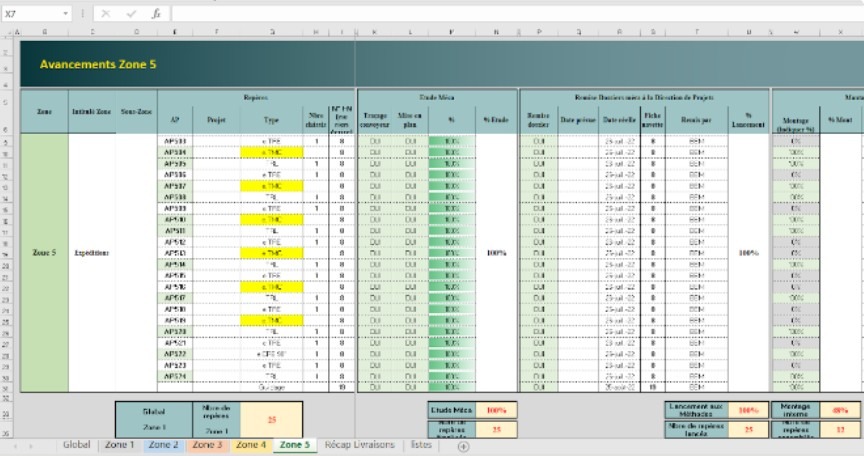
Progress tracking on Excel (before Pingflow)
The prototype: delivery in 3 months
Last advantage of this audit visit (and not the least interesting): the design of the flowboard (the visual management screen dedicated to piloting production) is much faster and more efficient.
“It was operational by July 2023, although we preferred the end of summer to fully utilize it,” explains Bruno Galiot. “The responsiveness of the Pingflow teams during this phase was impressive: we hadn’t finished entering a ticket to report a problem before it was already resolved!”

Deployment: Data and design, the magic ingredients for accelerated adoption
By November 2023, 100% of workshop production monitoring had switched to flowboards designed by Pingflow.
The key to this rapid adoption? For Dimitri Brachet, the answer lies in two words: data and design.
“For a flowboard (and for any digital visual management screen), users must have confidence in the quality of the information they are viewing, and visualize it in an ergonomic interface. If one of these two ingredients is missing, it’s a failure.” “And Pingflow has real expertise in design and UX (user experience),” adds Bruno Galiot.
The flowboard: a tool for smoother production
Visible activity close to the ground
The result? With Pingflow, Ciuch implemented a digital flowboard on touchscreens in the various production areas:
- manufacturing, assembly and shipping now have a real-time view of the progress of orders in the workshop,
- the information, centralized and updated automatically, provides visibility on what is being done in other workshops
- teams can therefore quickly adjust priorities based on actual production progress.
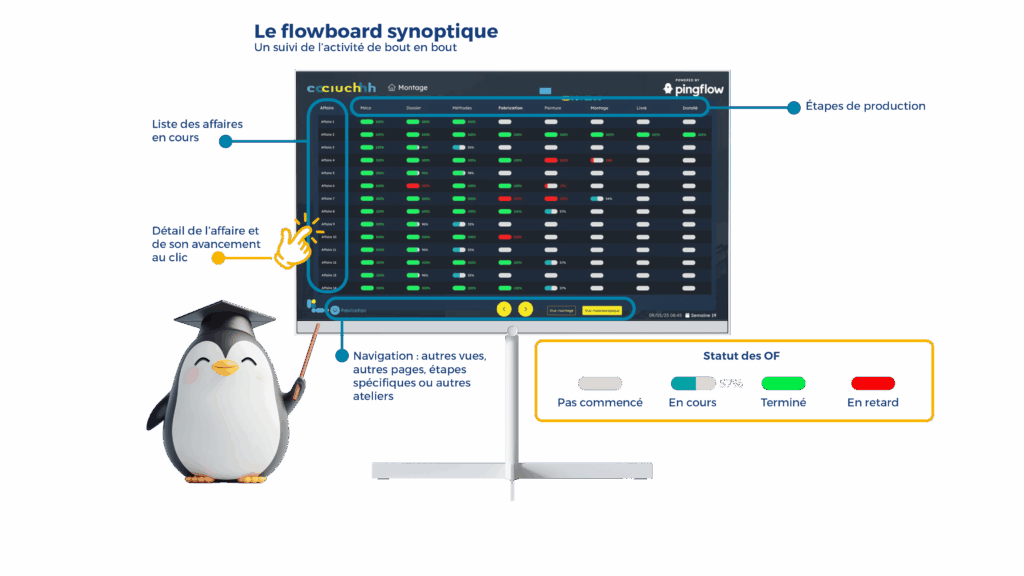
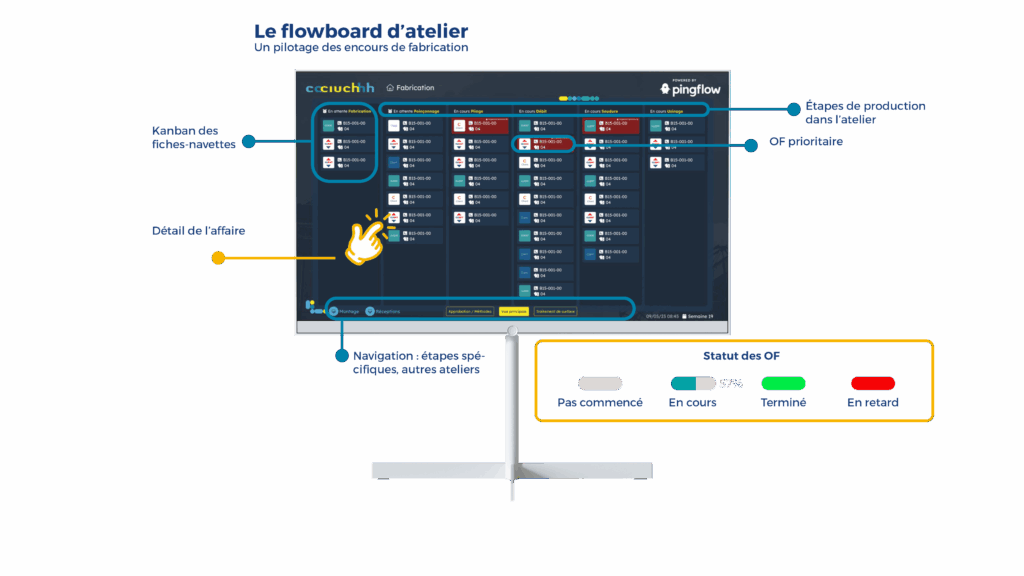
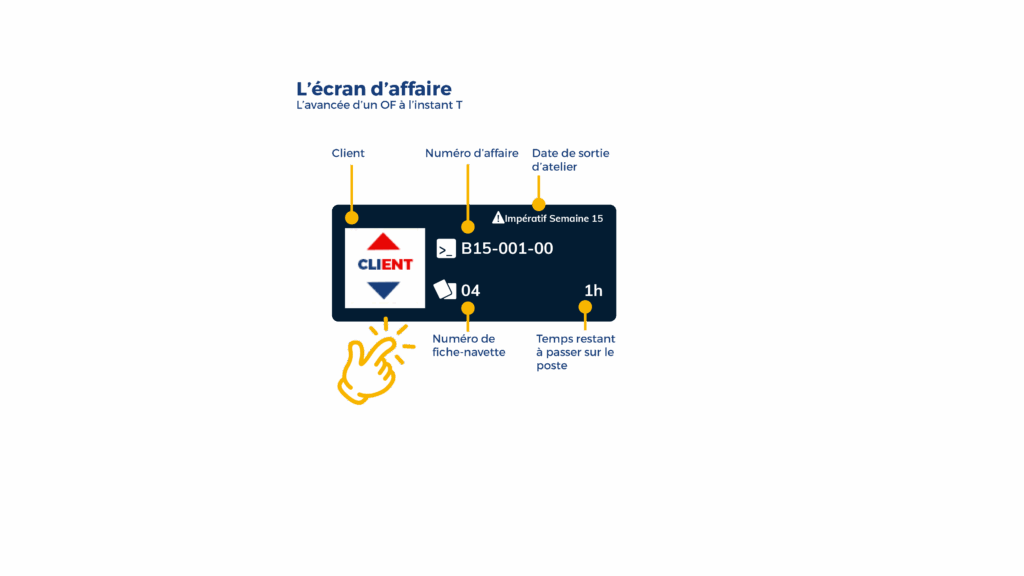
« The Flowboard has allowed us to structure our production without imposing too many drastic changes on our teams. Today, we are more responsive and better organized, » says Bruno Galiot.
The results: more visibility = more efficiency
The benefits of these flowboards, with a little over 18 months of hindsight?
- A significant time saving, with « clean, » accurate information right where operators and workshop managers need it, whereas previously, even the slightest check in the ERP (to which the flowboard is connected) was slow and tedious.
- An energy saving for the plant manager and workshop managers, who no longer need to go on-site to check that operations are running smoothly, check shuttle records, etc.
- Better coordination between departments: from the design office to the « back of the shop floor, » information is sent (and sent) in a few minutes, instead of several hours (or even days) before the flowboard is set up.
- Better responsiveness to unforeseen events.
- « Rolling » planning and scheduling, which Bruno Galiot now performs in a few minutes every day, rather than several hours at the weekend.
- Overall, more agile management, without having to disrupt the existing organization.
And then ?
Building on this success, Ciuch is already working on the next steps. The first direction? Expanding the use of flowboards to increase productivity. And moving from a system that remains largely handled by workshop managers to a tool that teams can fully embrace: by recording their actions, the progress of various production orders, etc. « We still need to develop our reflexes at this level, » acknowledges Bruno Galiot.
The second approach? Streamlining the arrival of orders in the production workshop by leveraging Table (Pingflow’s « No-Code » collaborative database) to streamline the creation of shuttle sheets directly when the plan is edited by the design office. « Eliminating this double entry, ensuring the quality of the shuttle sheet information, and being able to trigger its printing automatically would be a significant time saver, » anticipates Bruno Galiot.
And finally, in the longer term, Ciuch’s teams are exploring the implementation of connected AICs. The ambition? To further improve monitoring and communication between teams, and capitalize on data from production management for more effective team rituals.
